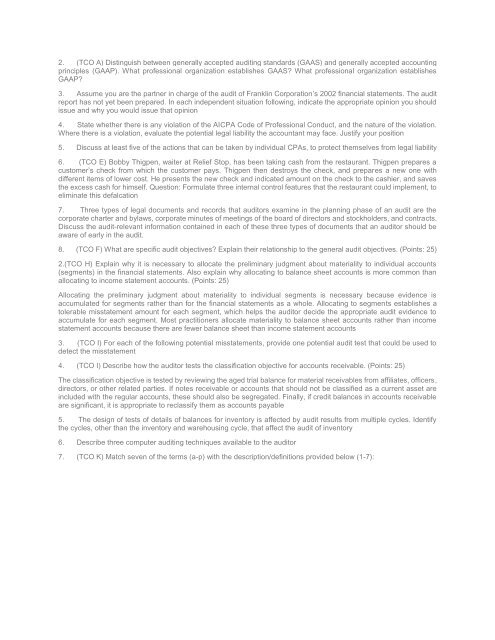ACCT 555 DeVry Entire Course
Create successful ePaper yourself
Turn your PDF publications into a flip-book with our unique Google optimized e-Paper software.
2. (TCO A) Distinguish between generally accepted auditing standards (GAAS) and generally accepted accounting<br />
principles (GAAP). What professional organization establishes GAAS? What professional organization establishes<br />
GAAP?<br />
3. Assume you are the partner in charge of the audit of Franklin Corporation’s 2002 financial statements. The audit<br />
report has not yet been prepared. In each independent situation following, indicate the appropriate opinion you should<br />
issue and why you would issue that opinion<br />
4. State whether there is any violation of the AICPA Code of Professional Conduct, and the nature of the violation.<br />
Where there is a violation, evaluate the potential legal liability the accountant may face. Justify your position<br />
5. Discuss at least five of the actions that can be taken by individual CPAs, to protect themselves from legal liability<br />
6. (TCO E) Bobby Thigpen, waiter at Relief Stop, has been taking cash from the restaurant. Thigpen prepares a<br />
customer’s check from which the customer pays. Thigpen then destroys the check, and prepares a new one with<br />
different items of lower cost. He presents the new check and indicated amount on the check to the cashier, and saves<br />
the excess cash for himself. Question: Formulate three internal control features that the restaurant could implement, to<br />
eliminate this defalcation<br />
7. Three types of legal documents and records that auditors examine in the planning phase of an audit are the<br />
corporate charter and bylaws, corporate minutes of meetings of the board of directors and stockholders, and contracts.<br />
Discuss the audit-relevant information contained in each of these three types of documents that an auditor should be<br />
aware of early in the audit.<br />
8. (TCO F) What are specific audit objectives? Explain their relationship to the general audit objectives. (Points: 25)<br />
2.(TCO H) Explain why it is necessary to allocate the preliminary judgment about materiality to individual accounts<br />
(segments) in the financial statements. Also explain why allocating to balance sheet accounts is more common than<br />
allocating to income statement accounts. (Points: 25)<br />
Allocating the preliminary judgment about materiality to individual segments is necessary because evidence is<br />
accumulated for segments rather than for the financial statements as a whole. Allocating to segments establishes a<br />
tolerable misstatement amount for each segment, which helps the auditor decide the appropriate audit evidence to<br />
accumulate for each segment. Most practitioners allocate materiality to balance sheet accounts rather than income<br />
statement accounts because there are fewer balance sheet than income statement accounts<br />
3. (TCO I) For each of the following potential misstatements, provide one potential audit test that could be used to<br />
detect the misstatement<br />
4. (TCO I) Describe how the auditor tests the classification objective for accounts receivable. (Points: 25)<br />
The classification objective is tested by reviewing the aged trial balance for material receivables from affiliates, officers,<br />
directors, or other related parties. If notes receivable or accounts that should not be classified as a current asset are<br />
included with the regular accounts, these should also be segregated. Finally, if credit balances in accounts receivable<br />
are significant, it is appropriate to reclassify them as accounts payable<br />
5. The design of tests of details of balances for inventory is affected by audit results from multiple cycles. Identify<br />
the cycles, other than the inventory and warehousing cycle, that affect the audit of inventory<br />
6. Describe three computer auditing techniques available to the auditor<br />
7. (TCO K) Match seven of the terms (a-p) with the description/definitions provided below (1-7):

















